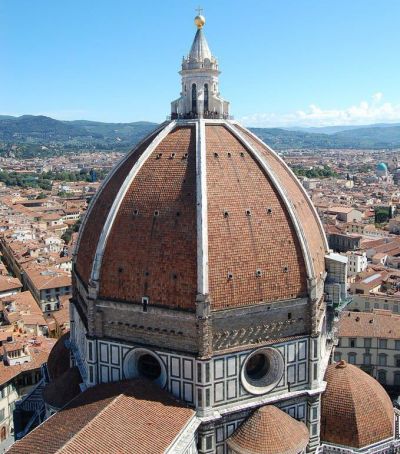One of the many wonderful things to do when visiting Italy is to admire the architecture, the Pantheon, Villa d’Este, Pisa’s Tower, and, of course, the Vatican. As you wander through these marvels, you cannot help but be impressed by their beauty and by the brilliance of those who created them. Chief among Italy’s architectural treasures is the dome of Florence’s Santa Maria del Fiore. Its construction, along with the genius that built it, Filippo Brunelleschi, is the subject of Ross King’s national bestseller, “Brunelleschi’s Dome, How a Renaissance Genius Reinvented Architecture”.
King’s work won the 2001 Book Sense Book of the Year Award for its ability to describe the complexities of the dome’s construction in an entertaining and understandable way. Although it is a work of non-fiction, it is a compelling read that discusses the technical challenges as well as the political interferences he had to battle to create what is the virtual crown of the Renaissance’s birthplace, Florence, Italy. An important aspect of the book is its scope. Much of the work deals with Brunelleschi himself, the man behind the creation, describing his travels to Rome to study the buildings of the past as well as much of his early work.
As King explains in his book, the builders of Santa Maria del Fiore faced a seemingly impossible problem. The dome was far too big. Construction had begun in 1296. At that time, domes were supported with flying buttresses. However, Santa Maria del Fiore’s dome was too heavy, with a circumference too great for the flying buttresses to support. It was said that it would have taken all the wood from all the forests in all of Italy to create the required buttresses. It wasn’t until 1417 that Brunelleschi, through his genius, provided a solution.
The book, however, is more than just a dry tome of interest only to architecture students. In King’s description of Brunelleschi’s life story, he provides insight into the forces that drove his artistic passion. Although primarily educated in mathematics, Brunelleschi excelled in the arts. To exploit this natural talent, he became a goldsmith and clockmaker.However, he was one of these rare people who excelled in multiple areas. One such area was architecture, where he married his technical and artistic skills. Although he enters and wins various architecture competitions, he is not taken seriously by the other architects in Florence because of his profession as a goldsmith. As King point’s out, Brunelleschi’s plan was only considered after all other solutions were dismissed because of apparent flaws.
In telling the story of the competition, King repeats a less than credible story by Giorgio Vasari. According to Vasari, Brunelleschi suggested that whoever could make an egg stand on its end on a flat piece of marble should win the competition. After all the others fail the test, Brunelleschi simply cracks the egg on one end, then stands it on the marble. When his competitors complained that they could have done the same, Brunelleschi responded that they could have, but they did not know how until they saw him do it. In the same way, they would know how to build the dome, too, if only they knew his plans. And thus, Brunelleschi was awarded the commission.
If this story were true, Brunelleschi gave his rivals too much credit. He did much more than develop a plan for the dome. He invented the tools and technologies necessary to make those plans a reality. For example, he created a reversible ox hoist that could raise and lower materials without the need to unharness the oxen, turn them around, and then reharness them again.
Brunelleschi is representative of the other greats of the Renaissance. Putting aside dogma, he studied the world around him, looking at it holistically. In so doing, he reshaped the world of architecture. To appreciate his unique genius, as well as the architectural achievement that is the dome of Santa Maria del Fiore, read “Brunelleschi’s Dome, How a Renaissance Genius Reinvented Architecture”. It is a quick, easy read that is both enlightening and entertaining.
https://www.lagazzettaitaliana.com/history-culture/10194-brunelleschi-s-dome#sigProIde02375c626




